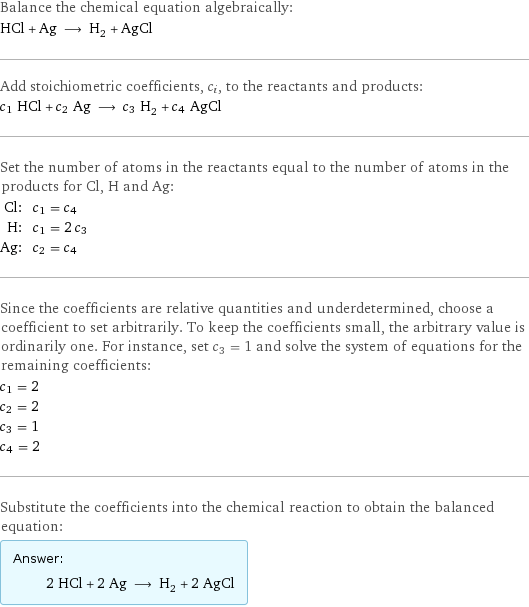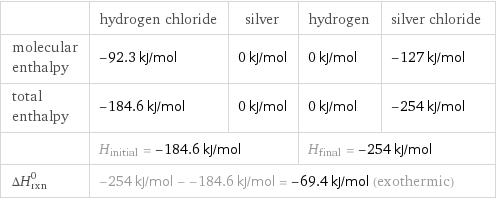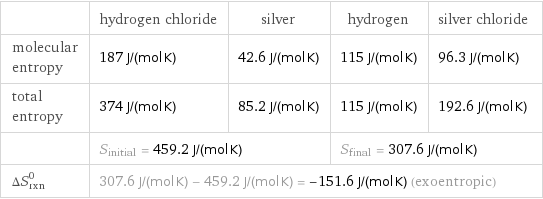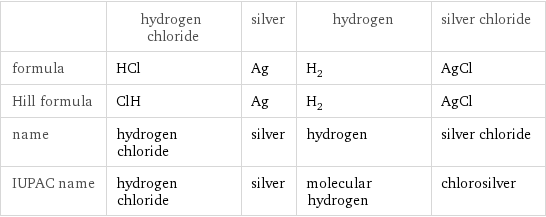Input interpretation

HCl hydrogen chloride + Ag silver ⟶ H_2 hydrogen + AgCl silver chloride
Balanced equation

Balance the chemical equation algebraically: HCl + Ag ⟶ H_2 + AgCl Add stoichiometric coefficients, c_i, to the reactants and products: c_1 HCl + c_2 Ag ⟶ c_3 H_2 + c_4 AgCl Set the number of atoms in the reactants equal to the number of atoms in the products for Cl, H and Ag: Cl: | c_1 = c_4 H: | c_1 = 2 c_3 Ag: | c_2 = c_4 Since the coefficients are relative quantities and underdetermined, choose a coefficient to set arbitrarily. To keep the coefficients small, the arbitrary value is ordinarily one. For instance, set c_3 = 1 and solve the system of equations for the remaining coefficients: c_1 = 2 c_2 = 2 c_3 = 1 c_4 = 2 Substitute the coefficients into the chemical reaction to obtain the balanced equation: Answer: | | 2 HCl + 2 Ag ⟶ H_2 + 2 AgCl
Structures

+ ⟶ +
Names

hydrogen chloride + silver ⟶ hydrogen + silver chloride
Reaction thermodynamics
Enthalpy

| hydrogen chloride | silver | hydrogen | silver chloride molecular enthalpy | -92.3 kJ/mol | 0 kJ/mol | 0 kJ/mol | -127 kJ/mol total enthalpy | -184.6 kJ/mol | 0 kJ/mol | 0 kJ/mol | -254 kJ/mol | H_initial = -184.6 kJ/mol | | H_final = -254 kJ/mol | ΔH_rxn^0 | -254 kJ/mol - -184.6 kJ/mol = -69.4 kJ/mol (exothermic) | | |
Entropy

| hydrogen chloride | silver | hydrogen | silver chloride molecular entropy | 187 J/(mol K) | 42.6 J/(mol K) | 115 J/(mol K) | 96.3 J/(mol K) total entropy | 374 J/(mol K) | 85.2 J/(mol K) | 115 J/(mol K) | 192.6 J/(mol K) | S_initial = 459.2 J/(mol K) | | S_final = 307.6 J/(mol K) | ΔS_rxn^0 | 307.6 J/(mol K) - 459.2 J/(mol K) = -151.6 J/(mol K) (exoentropic) | | |
Equilibrium constant
![Construct the equilibrium constant, K, expression for: HCl + Ag ⟶ H_2 + AgCl Plan: • Balance the chemical equation. • Determine the stoichiometric numbers. • Assemble the activity expression for each chemical species. • Use the activity expressions to build the equilibrium constant expression. Write the balanced chemical equation: 2 HCl + 2 Ag ⟶ H_2 + 2 AgCl Assign stoichiometric numbers, ν_i, using the stoichiometric coefficients, c_i, from the balanced chemical equation in the following manner: ν_i = -c_i for reactants and ν_i = c_i for products: chemical species | c_i | ν_i HCl | 2 | -2 Ag | 2 | -2 H_2 | 1 | 1 AgCl | 2 | 2 Assemble the activity expressions accounting for the state of matter and ν_i: chemical species | c_i | ν_i | activity expression HCl | 2 | -2 | ([HCl])^(-2) Ag | 2 | -2 | ([Ag])^(-2) H_2 | 1 | 1 | [H2] AgCl | 2 | 2 | ([AgCl])^2 The equilibrium constant symbol in the concentration basis is: K_c Mulitply the activity expressions to arrive at the K_c expression: Answer: | | K_c = ([HCl])^(-2) ([Ag])^(-2) [H2] ([AgCl])^2 = ([H2] ([AgCl])^2)/(([HCl])^2 ([Ag])^2)](../image_source/3db396b927eeb25b439aa2ddaf2918ae.png)
Construct the equilibrium constant, K, expression for: HCl + Ag ⟶ H_2 + AgCl Plan: • Balance the chemical equation. • Determine the stoichiometric numbers. • Assemble the activity expression for each chemical species. • Use the activity expressions to build the equilibrium constant expression. Write the balanced chemical equation: 2 HCl + 2 Ag ⟶ H_2 + 2 AgCl Assign stoichiometric numbers, ν_i, using the stoichiometric coefficients, c_i, from the balanced chemical equation in the following manner: ν_i = -c_i for reactants and ν_i = c_i for products: chemical species | c_i | ν_i HCl | 2 | -2 Ag | 2 | -2 H_2 | 1 | 1 AgCl | 2 | 2 Assemble the activity expressions accounting for the state of matter and ν_i: chemical species | c_i | ν_i | activity expression HCl | 2 | -2 | ([HCl])^(-2) Ag | 2 | -2 | ([Ag])^(-2) H_2 | 1 | 1 | [H2] AgCl | 2 | 2 | ([AgCl])^2 The equilibrium constant symbol in the concentration basis is: K_c Mulitply the activity expressions to arrive at the K_c expression: Answer: | | K_c = ([HCl])^(-2) ([Ag])^(-2) [H2] ([AgCl])^2 = ([H2] ([AgCl])^2)/(([HCl])^2 ([Ag])^2)
Rate of reaction
![Construct the rate of reaction expression for: HCl + Ag ⟶ H_2 + AgCl Plan: • Balance the chemical equation. • Determine the stoichiometric numbers. • Assemble the rate term for each chemical species. • Write the rate of reaction expression. Write the balanced chemical equation: 2 HCl + 2 Ag ⟶ H_2 + 2 AgCl Assign stoichiometric numbers, ν_i, using the stoichiometric coefficients, c_i, from the balanced chemical equation in the following manner: ν_i = -c_i for reactants and ν_i = c_i for products: chemical species | c_i | ν_i HCl | 2 | -2 Ag | 2 | -2 H_2 | 1 | 1 AgCl | 2 | 2 The rate term for each chemical species, B_i, is 1/ν_i(Δ[B_i])/(Δt) where [B_i] is the amount concentration and t is time: chemical species | c_i | ν_i | rate term HCl | 2 | -2 | -1/2 (Δ[HCl])/(Δt) Ag | 2 | -2 | -1/2 (Δ[Ag])/(Δt) H_2 | 1 | 1 | (Δ[H2])/(Δt) AgCl | 2 | 2 | 1/2 (Δ[AgCl])/(Δt) (for infinitesimal rate of change, replace Δ with d) Set the rate terms equal to each other to arrive at the rate expression: Answer: | | rate = -1/2 (Δ[HCl])/(Δt) = -1/2 (Δ[Ag])/(Δt) = (Δ[H2])/(Δt) = 1/2 (Δ[AgCl])/(Δt) (assuming constant volume and no accumulation of intermediates or side products)](../image_source/9b6a7cd4bcf6306df38ad4dec60f0fd0.png)
Construct the rate of reaction expression for: HCl + Ag ⟶ H_2 + AgCl Plan: • Balance the chemical equation. • Determine the stoichiometric numbers. • Assemble the rate term for each chemical species. • Write the rate of reaction expression. Write the balanced chemical equation: 2 HCl + 2 Ag ⟶ H_2 + 2 AgCl Assign stoichiometric numbers, ν_i, using the stoichiometric coefficients, c_i, from the balanced chemical equation in the following manner: ν_i = -c_i for reactants and ν_i = c_i for products: chemical species | c_i | ν_i HCl | 2 | -2 Ag | 2 | -2 H_2 | 1 | 1 AgCl | 2 | 2 The rate term for each chemical species, B_i, is 1/ν_i(Δ[B_i])/(Δt) where [B_i] is the amount concentration and t is time: chemical species | c_i | ν_i | rate term HCl | 2 | -2 | -1/2 (Δ[HCl])/(Δt) Ag | 2 | -2 | -1/2 (Δ[Ag])/(Δt) H_2 | 1 | 1 | (Δ[H2])/(Δt) AgCl | 2 | 2 | 1/2 (Δ[AgCl])/(Δt) (for infinitesimal rate of change, replace Δ with d) Set the rate terms equal to each other to arrive at the rate expression: Answer: | | rate = -1/2 (Δ[HCl])/(Δt) = -1/2 (Δ[Ag])/(Δt) = (Δ[H2])/(Δt) = 1/2 (Δ[AgCl])/(Δt) (assuming constant volume and no accumulation of intermediates or side products)
Chemical names and formulas

| hydrogen chloride | silver | hydrogen | silver chloride formula | HCl | Ag | H_2 | AgCl Hill formula | ClH | Ag | H_2 | AgCl name | hydrogen chloride | silver | hydrogen | silver chloride IUPAC name | hydrogen chloride | silver | molecular hydrogen | chlorosilver
Substance properties

| hydrogen chloride | silver | hydrogen | silver chloride molar mass | 36.46 g/mol | 107.8682 g/mol | 2.016 g/mol | 143.32 g/mol phase | gas (at STP) | solid (at STP) | gas (at STP) | solid (at STP) melting point | -114.17 °C | 960 °C | -259.2 °C | 455 °C boiling point | -85 °C | 2212 °C | -252.8 °C | 1554 °C density | 0.00149 g/cm^3 (at 25 °C) | 10.49 g/cm^3 | 8.99×10^-5 g/cm^3 (at 0 °C) | 5.56 g/cm^3 solubility in water | miscible | insoluble | | dynamic viscosity | | | 8.9×10^-6 Pa s (at 25 °C) | odor | | | odorless |
Units
